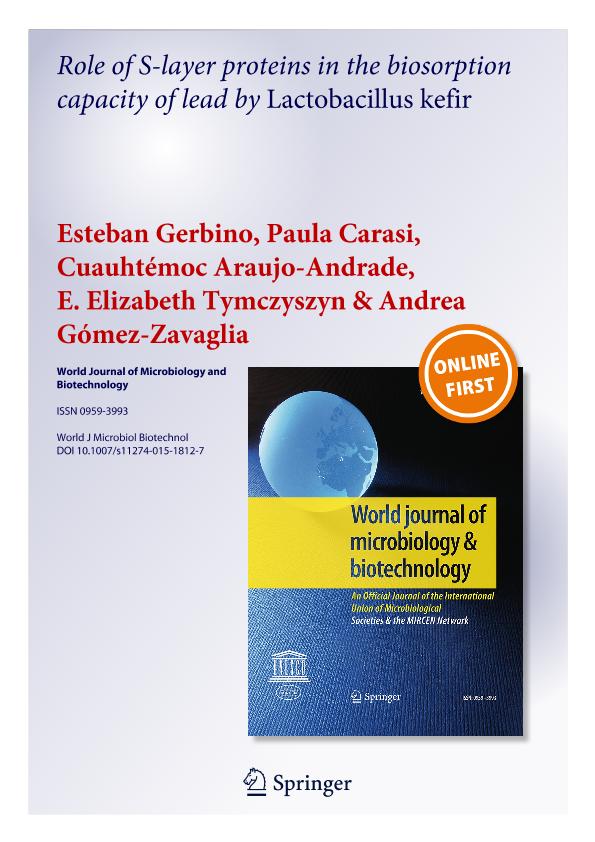Artículo
Role of S-layer proteins in the biosorption capacity of lead by Lactobacillus kefir
Gerbino, Oscar Esteban ; Carasi, Paula
; Carasi, Paula ; Araujo Andrade, Cuauhtémoc; Tymczyszyn, Emma Elizabeth
; Araujo Andrade, Cuauhtémoc; Tymczyszyn, Emma Elizabeth ; Gomez Zavaglia, Andrea
; Gomez Zavaglia, Andrea
 ; Carasi, Paula
; Carasi, Paula ; Araujo Andrade, Cuauhtémoc; Tymczyszyn, Emma Elizabeth
; Araujo Andrade, Cuauhtémoc; Tymczyszyn, Emma Elizabeth ; Gomez Zavaglia, Andrea
; Gomez Zavaglia, Andrea
Fecha de publicación:
02/2015
Editorial:
Springer
Revista:
World Journal of Microbiology
ISSN:
0959-3993
e-ISSN:
1573-0972
Idioma:
Inglés
Tipo de recurso:
Artículo publicado
Clasificación temática:
Resumen
The role of S-layer proteins (SLP) on the Pb2+ sequestrant capacity by Lactobacillus kefir CIDCA 8348 and JCM 5818 was investigated. Cultures in the stationary phase were treated with proteinase K. A dot blot assay was carried out to assess the removal of SLP. Strains with and without SLP were exposed to 0–0.5 mM Pb(NO3)2. The maximum binding capacity (qmax) and the affinity coefficient (b) were calculated using the Langmuir equation. The structural effect of Pb2+ on microorganisms with and without SLP was determined using Raman spectroscopy. The bacterial interaction with Pb2+ led to a broadening in the phosphate bands (1,300–1,200 cm−1 region) and strong alterations on amide and carboxylate-related bands (νCOO− as and νCOO− s). Microorganisms without SLP removed higher percentages of Pb2+ and had higher qmax than those bearing SLP. Isolated SLP had much lower qmax and also removed lower percentages of Pb2+ than the corresponding whole microorganisms. The hydrofobicity of both strains dramatically dropped when removing SLP. When bearing SLP, strains do not expose a large amount of charged groups on their surfaces, thus making less efficient the Pb2+ removal. On the contrary, the extremely low hydrofobicity of microorganisms without SLP (and consequently, their higher capacity to remove Pb2+) can be explained on the basis of a greater exposure of charged chemical groups for the interaction with Pb2+. The viability of bacteria without SLP was not significantly lower than that of bacteria bearing SLP. However, microorganisms without SLP were more prone to the detrimental effect of Pb2+, thus suggesting that SLP acts as a protective rather than as a sequestrant layer.
Palabras clave:
BIOSORPTION
,
LACTOBACILLUS KEFIR
,
LEAD
,
S-LAYER PROTEINS
Archivos asociados
Licencia
Identificadores
Colecciones
Articulos(CIDCA)
Articulos de CENTRO DE INV EN CRIOTECNOLOGIA DE ALIMENTOS (I)
Articulos de CENTRO DE INV EN CRIOTECNOLOGIA DE ALIMENTOS (I)
Citación
Gerbino, Oscar Esteban; Carasi, Paula; Araujo Andrade, Cuauhtémoc; Tymczyszyn, Emma Elizabeth; Gomez Zavaglia, Andrea; Role of S-layer proteins in the biosorption capacity of lead by Lactobacillus kefir; Springer; World Journal of Microbiology; 31; 4; 2-2015; 583-592
Compartir
Altmétricas



